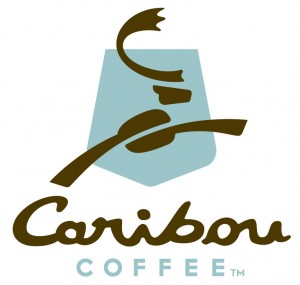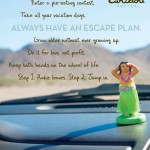 Today, one of my favorite local companies–Caribou Coffee–is rolling out a complete brand makeover.
Today, one of my favorite local companies–Caribou Coffee–is rolling out a complete brand makeover.
According to the news release, the company’s new brand look includes “a new logo, color palette and design elements that bring fresh energy and broader context to the existing tag line: Life is short. Stay awake for it (R).”
Luckily, I got a sneak peek at the new brand over the weekend thanks to my friends over at Exponent, Caribou’s PR agency-of-record.
In addition to the release, the media kit also included a four-color brochure based on the new brand, another four-color piece that explains the rationale behind the new logo and look and feel, a custom jump drive (thanks!) full of logos and visuals and one of the new Caribou cups.
 The media kit was well done. Full of information (and electronic visuals) a journalist or blogger could use to write a story or post about the new re-brand.
The media kit was well done. Full of information (and electronic visuals) a journalist or blogger could use to write a story or post about the new re-brand.
But, here’s my question: Is this really a re-brand or just a new visual identity system?
At the heart of that question is a larger issue for all organizations: Is a brand more than just a logo?
For many companies, the logo or visual identity of the brand is the foundational element for the brand itself. Think about logos and symbols like Target, McDonalds, Starbucks. These logos have become pervasive across not only American culture–but around the world. They each stand for something different–and each conjures up different feelings and emotions for the customer.
But, at the end of the day, the Target “bullseye” is just a logo, isn’t it?
I remember working for an organization earlier in my career that went through a re-branding process. I wasn’t privy to all the behind-the-scenes meetings and decisions at that time, but I got wind of the branding changes along the line. In essence, it was a visual identity change. We were changing the basic “look and feel” of what this brand meant visually to our stakeholders. A new color palette. A new typeface. A new look. And, changes to all our letterhead and marketing communications materials.
Looking back on that situation now, was it really a “re-brand” or merely a shift in art direction?
Doesn’t re-branding constitute a lot more than just a logo change? Think about it. What is a brand, really? According to Wikipedia a brand is a name used to identify and distinguish a specific product, service or business. OK, fair enough. But, to me, a brand represents the collection of all the thoughts, feelings, perceptions and attitudes a customer has toward a product, service or organization. That’s a hell of a lot more than just a logo.
So then, why do we continue to call a simple logo change a “re-brand?”
My advice: Organizations need to do a better job of sharing the stories and experiences that make up their brands. That’s really what’s at the heart of a brand, isn’t it? Yes, the logo and visual identity are key pieces of the brand puzzle–but they’re just one of the elements. What about the story about how your customer service representative went the extra mile to make a client’s day? What about photos from your customers using or experiencing your product or service? What about a phone call from a customer where she talks about how your service completely changed her life? Those are the experiences that define your brand. Those are the shared stories that form the basis for your potential customer’s perceptions and attitudes about your brand. And, quite often, those are the ideas that pop into people’s heads when they’re making purchase decisions, too.
Think about a company like Southwest Airlines. Do people fly Southwest because of their colorful planes or their logo? Or, do they fly Southwest because of the stories they hear about the brand’s over-the-top-fantastic customer service (despite the recent Kevin Smith story)? What about the tales of people singing on the flights? Or, maybe the tweet that read: “Best. Flight. Ever.” Think any of those stories or shared experiences make a difference when someone’s making a decision about what airline to fly?
To be clear, I’m not saying a logo or visual identity system isn’t important. It is. Absolutely. And, I’m not calling out Caribou–I continue to be a huge (I cannot emphasize that strongly enough) fan. I just think your logo should be a piece of your brand–it shouldn’t define it.
The next time your company is thinking about a “re-branding” campaign, start with the heart of the matter first. Your employees. Your stories. The experiences your customers share that make you unique. The complete brand picture.
What do you think? Agree? Disagree? I’d love to hear your take in the comments below.

0 Comments